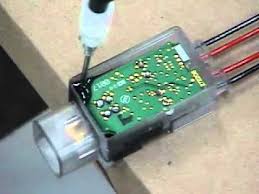How to Choose Between Potting and Conformal Coating
Posted by Sean Horn
Friday, October 14, 2016 7:31
@ 7:31 AM
Protection of printed circuit boards (PCBs) is most often achieved with either potting or conformal coating. The selection of which method to use depends upon the PCB’s purpose and how much protection it requires. Potting offers the strongest shielding barrier, but is also affected by a range of operational disadvantages that can offset its functional benefits. Conformal coatings generate reliable barrier protection, which frequently circumvent the problems inherent in potting. This is particularly the case with parylene, a non-liquid conformal coating.
Potting Properties
Potting is a two-step process, wherein a PCB is first protected from the surrounding environment by insertion (embedding) into a case or shell (the “pot”). A liquid potting compound is then poured over and around the containerized PCB, encasing it completely within.
Materially, certain epoxy resins make suitable potting compounds; thermo-setting plastics or silicone rubber gels are also frequently used. More specifically, a PCB employing surface-mount technology benefits from application of lower glass transition temperature (Tg) potting compounds like urethane or silicone; high Tg potting compounds may break solder bonds as they harden and shrink at low temperatures.
However, most potting applications use epoxy because of its adhesive, electrical, mechanical and thermal properties. Selection of the wrong potting for your application can generate unwanted stresses or heat. If necessary, colored compounds can effectively obscure the PCB’s visual appearance, for extra product protection, in cases where competitors or others seek to reverse-engineer the item and its function.
Benefits
Potting techniques are particularly adaptable for high-speed, automated line-production, where the objective is manufacture of many-units-per-hour. Potting cases are secure, and offer dielectric protection, while preventing contaminants from penetrating the device. Prominent potting compounds like epoxy and parylene are also chemically inert, safeguarding the PCB from the polluting effects of acids, bases, corrosion, salt and most solvents.
 In this respect, potting is often the method of clear choice for:
In this respect, potting is often the method of clear choice for:
- impact resistance,
- assured vibration dampening,
- heat dissipation, and
- conditions where assembly privacy and security are necessary to product performance.
Disadvantages
Despite potting’s demonstrated protective-utility for PCB assemblies, it lacks the sufficient flexibility for many component applications, limiting its overall use. Other disadvantages of potting include:
- extreme difficulty reworking potted assemblies contained as they are within cases,
- inability to overcome restrictions to coating thickness or assembly weight due to encasement, and
- housing design flaws that generate a surface susceptible to material-strain during compound shrinkage, causing PCB damage. Also,
- utilizing underfills to enhance shock-robustness can encourage failure under thermal cycling.
Properties of Conformal Coatings
Unlike potting, conformal coatings add a protective film specifically to the substrate surface, without encapsulating techniques. Their much thinner surface coatings are far less weighty than potting encasements, and can be adapted to numerous applications. With a coating that conforms to the contours of the substrate, they generate non-conductive, dielectric protection that increases a PCB’s electrical performance.
Wet conformal coatings –_acrylic, epoxy, silicone and urethane — are applied via liquid methods, brushing, dipping or spraying the coating directly onto the substrate surface. Each wet coating offers a range of uses, specific to its particular properties:
- Acrylics are popular conformal because they are easy to apply and rework, cure quickly and are fungus/moisture resistant.
- Epoxy is exceptionally durable but difficult to remove or rework.
- Silicone is also difficult to rework, but is moisture resistant and remains chemically stable at 200`C, providing good protection in environments typified by chemicals, solvents or vibration.
- Urethane’s dielectric properties insulate signal traces from circuits situated in close proximity, making it useful for MEMS/Nano applications. It inhibits tin whisker growth while generating abrasion, chemical and humidity resistance.
Parylene not only differs from other conformal coatings, but is also very different from potting in process and result. Applied in a gaseous state via chemical vapor deposition (CVD), its protective film penetrates deep into the assembly’s surface, creating a protective coat that covers it entirely — even under parts and inside gaps. Unlike the bloc-coating outcome common to potting, parylene’s protective film is exceptionally thin — usually measured in microns — and essentially invisible. Parylene
- is chemically inert protecting against acid, bases, corrosion, salt, and most solvents,
- offers good dielectric protection,
- blocks humidity and moisture,
- withstands extremes of physical stress and temperature, and
- is pinhole-free, with the thinnest available coating, measured in microns, making it very suitable for MEMS/Nano applications.
However, like potting, parylene is also difficult to remove and rework. It is a slow, expensive process, as well, limiting its present applications.
Conclusion
PCBs used in environments characterized by persistent exposure to abrasive fluids, corrosion, fungus, humidity, salt/sand-spray or temperature extremes, experience performance issues. Encapsulating or conformally-coating PCBs helps mitigate these problems. Potting and conformal coating processes lessen operational fatigue, enhancing PCB-performance. Both are:
- effective when used in the right situation, but remain
- characterized by numerous variables that determine cost, effectiveness, and turnaround time.
Thus, it may be advisable to seek professional assistance to develop solutions that coincide with your firm’s project, budget, and timeline. Conformal coatings have surpassed potting as the most-used protective PCB-covering; among them, parylene offers the widest range of reliable coating options.
To learn more about conformal coatings and how potting compares, download our Basics of Conformal Coatings whitepaper:
{{cta(‘d21b6a8c-1a83-4910-a03e-7ad2a221b18e’)}}
Comments
Homepage 4/17/2020. 10:17:10 AM
... [Trackback] [...] Informations on that Topic: blog.paryleneconformalcoating.com/whats-the-difference-between-potting-and-conformal-coating/ [...]

londondrugscanada.bigcartel.comlondon-drugs 4/17/2020. 10:17:10 AM
cialis uk https://londondrugscanada.bigcartel.com/london-drugs This is nicely expressed. !